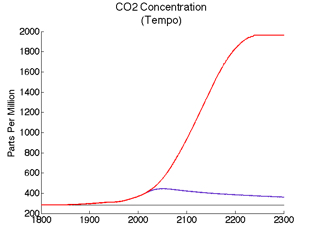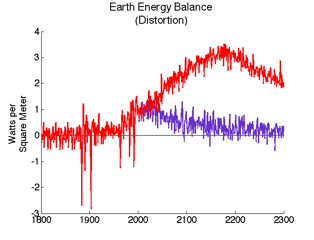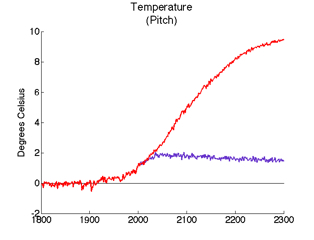Composers who tell this story will help audiences understand how the physical aspects of climate are related – and how human activities impact climate change. This story focuses on just one example of how human actions have already impacted the climate, and how they will continue to do so in the future, depending on what actions we take now and in the future. Telling this story will help audiences grasp scientific concepts and hear the effects of our actions on the world.
Key points:
- Human activity has already caused measurable warming of the global climate.
- How bad it will get depends on what we do today: our past and current carbon dioxide emissions are like a debt that is paid by future generations. They remain in the atmosphere, trapping heat for up to 200 years.
- If we act with urgency now, it is still possible to keep future warming to a minimum. If we fail to act now, by the end of this century we will have knowingly brought on climatic conditions never before experienced by humans.
Reminder: the core of our collaboration is your interaction with our science team; this page is only to provide a reference to the science outside of our interactions.
If you want to learn more…
How increasing emissions of carbon dioxide have affected the climate over the past 200+ years and will affect the climate in the future
In this story, increasing levels of carbon dioxide in the atmosphere from human activity (such as the burning of fossil fuels) trap extra energy within the atmosphere. This throws the energy balance out of equilibrium. The extra energy in the atmosphere caused by humans is given off as heat (thermal energy), which increases the air temperature near the surface of the Earth. Greenhouse gases have to be removed from the atmosphere for the energy balance to go back into equilibrium. We’re pretty much stuck with the 2.6W/m2 from emissions that have already happened.
The three “actors” in the story are:
- carbon dioxide (CO2) concentrations in the atmosphere
- the global, annual air temperature
- the Earth’s energy balance.
The main “actor” in this story is carbon dioxide, a “greenhouse gas” that traps solar energy within our atmosphere, causing warming. CO2 is an odorless, colorless gas that occurs naturally, and is responsible for our planet’s habitable temperature – it is the product of respiration by bacteria and animals (including humans), and is the source of carbon that plants turn into sugars during photosynthesis. CO2 is also the product of burning fossil fuels, and causes more heat to be trapped within our atmosphere, creating warming.
The global near Earth air temperature in this case is defined as the average temperature around the globe over the course of the year, rather than the temperature in any one given location at a given time. When you read in the news that the world community needs to keep warming to less than 2 degrees Celsius, what is meant is a global mean of less than 2 degrees C over time. It does not mean, for example, the difference between 22-24 degrees C in San Francisco on a particular day.
The Earth energy balance is the balance between incoming energy from the sun and outgoing energy in the form of infrared radiation from the Earth. In order for there to be a stable mean near Earth air temperature, incoming and outgoing energy should be in balance.
There are three things that you should consider when working with the data sets:
- Natural variability. You will notice that the temperature and energy balance data have natural variations in them which reflect processes that have nothing to do with carbon dioxide emissions. For instance, in the year 1883 the volcano Krakatoa, near today’s Indonesia, erupted, disrupting the energy balance and causing a slight decline in average global near Earth air temperature. But you will see that these natural variations are relatively small over the time frame in the data when compared to the impact of carbon dioxide emissions.
- Time lags. The climate system does not turn on a dime. There is a lag between the time that we release carbon dioxide into the atmosphere and when the impact is felt in the form of higher temperatures. So even if we decide to stop emissions of all greenhouse gases tomorrow, the temperature would continue to rise because of our emissions today and in the past. That’s one of the reasons why action on climate change is urgent now.
- The scale of possible future change. From the early 21st Century, the data sets incorporate two possible future scenarios. One (called “RCP8.5”) models a future in which the world community does little or nothing to reinin carbon emissions. This is projected to result in an approximately 9 degree Celsius rise in global temperature and catastrophic impacts by the year 2250 AD. The second scenario (“RCP2.6”) represents a more hopeful “2 degree” world in which society succeeds in reining in emissions during the first half of this century.



Audio References (sonifications).
These sonification files (temperature data) by composer Mary (Molly) Monahan are provided to give you an intuitive way to understand the data. Three diverse versions are included here, reflecting a wide range of creative possibilities. Note: A gong sounds when the data reaches the present day, and BAU=”Business as Usual”and MIT=”We Act Now”.
Version 1: Business as Usual
Version 1: We Act Now
Version 2: Business As Usual
Version 2: We Act Now
Version 3: Business As Usual
Version 3: We Act Now
Other greenhouse gases include methane and nitrous oxide, among others. To better understand what a greenhouse gas is, please visit this site.
For more detailed description of how the Earth Energy Balance works, please visit this site.
To learn why a volcano can affect the climate, please visit this site.
To better understand why this is significant, please visit this site.